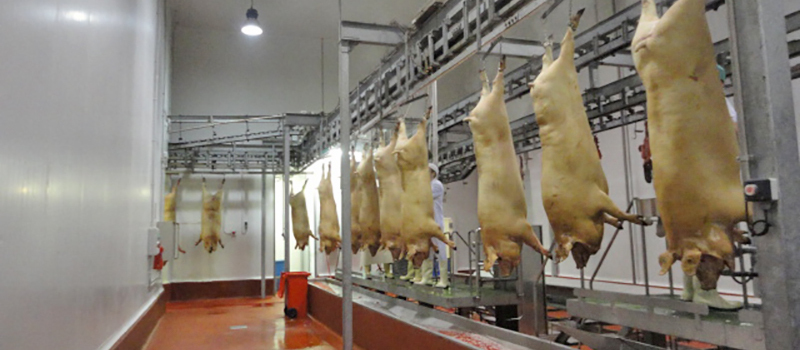How to avoid contamination in pig carcasses?

Pork carcasses are the most likely to be contaminated in slaughterhouses, and it is possible to avoid this to ensure a good return on investment
Pig meat is a complex kind to process, almost from the very beginning of the animal arrival to the slaughterhouse. Pig carcasses, as we have explained in previous articles, go through more phases than other type of meat before it arrives to our tables. This implies more risk of contamination while it is manipulated within slaughterhouses. Deseases such as salmonellosis can mean the loss of large volume of pieces, affecting to investment, ranchers and producers.
The main way of infection is related to the contact between the carcasses themselves and the human contact that the workers may have with them. The movement of carcasses has traditionally been manually, and this has presented many issues that have led to contamination. For example, during bleeding or dressing phases, the operator moves the carcass through the rail, coming into contact with the carcass by his hands, to proceed to move another piece. In this process, some bacteria might be transferred from one carcass to other by human contact. On the other hand, without a proper trolleys separation in the track, and in the absence of an automated rail system, pig carcasses can get in contact between them, contaminating one to other.
This may means, not an isolated carcass contaminated, but of entire batches. Fortunately, technology and hiegienic controls have evolved to assure the quality and profitabilty of producers. Among the amount of contributions that can be made to avoid economic, energy and even enviromental losses due to carcasses contamination, two stand out that could add up to all: the automation of processes and investment in technology.
Automating production processes in slaughterhouses can make the difference between making profitable and increasing profits, and between large losses of raw material. Therefore, there are some keys with which you can avoid and even reduce channel contamination to minimal percentages.
AUTOMATE BLEEDING AND DRESSING
Installing a bleeding conveyor or a dressing conveyor means a very profitable investment to achieve tidyness and cleaning in the processes. Therefore, it is recommended to avoid as much its possible, the human contact with the carcasses. With a bleeding conveyor, the carcasses are hoisted and hanged from the stunning phase, and are moved along the different machines, without any need of intervention by the operators, and maintaining the appropriate distance between them.
It is recommended to ensure the highest cleaning level possible achievable during the bleeding phase, before it enters into the scalding. To not infecting the water of the scalding with the dirt the animals bring from the pens, a whipping drying machine previous the scalding helps to reduce remarkably this dirt.
modern machinery for cleaning
Processes such as burning or flaming pigs have also traditionally been carried out manually, with the consequent loss of effectiveness due to human mistakes. Thus, the worker may forget parts of the carcass during the burning, or not perform the duty during the time required, leaving some gaps that can lead to carcass contamination. This is why machinery like the singer burner works the carcass from every angle, making also possible the regulation of the exposure time, and reducing this way the possibility of contamination by almost the 100%. This example is added to others, like placing whipping machines before and after the dehairing to top off the carcasses and eliminate any kind of dirt, hair or bacteria that might stay adhered to them.
AUTOMATIC bottom KNOTTING
In the dressing phase, it is necessary the cutting and knotting of the animal anus to avoid any undesirable evacuation, dirtying the carcass. This process is usually done manually, and now can be perform with a special gun than operates in a minimal time (2 seconds). Thus, effort and time are saved, so it permits to avoid the work to be performed with knifes that might not be properly sterilized.
STERILIZATION AND CLEANING EQUIPMENT IN ALL WORKSTATIONS
In the bleeding phase and in the dressing phase, knives are the main tools for the operators and it is essential to ensure their sterilization and sanitation so that, for reasons of speed or lack of logistics, the operator ends up performing the same operation on different channels with contaminated instruments. For this reason, it is recommended that all workstations have sinks and knife sterilizers as cleaning points, and that rigorous disinfection routines be established to ensure correct and clean work.




